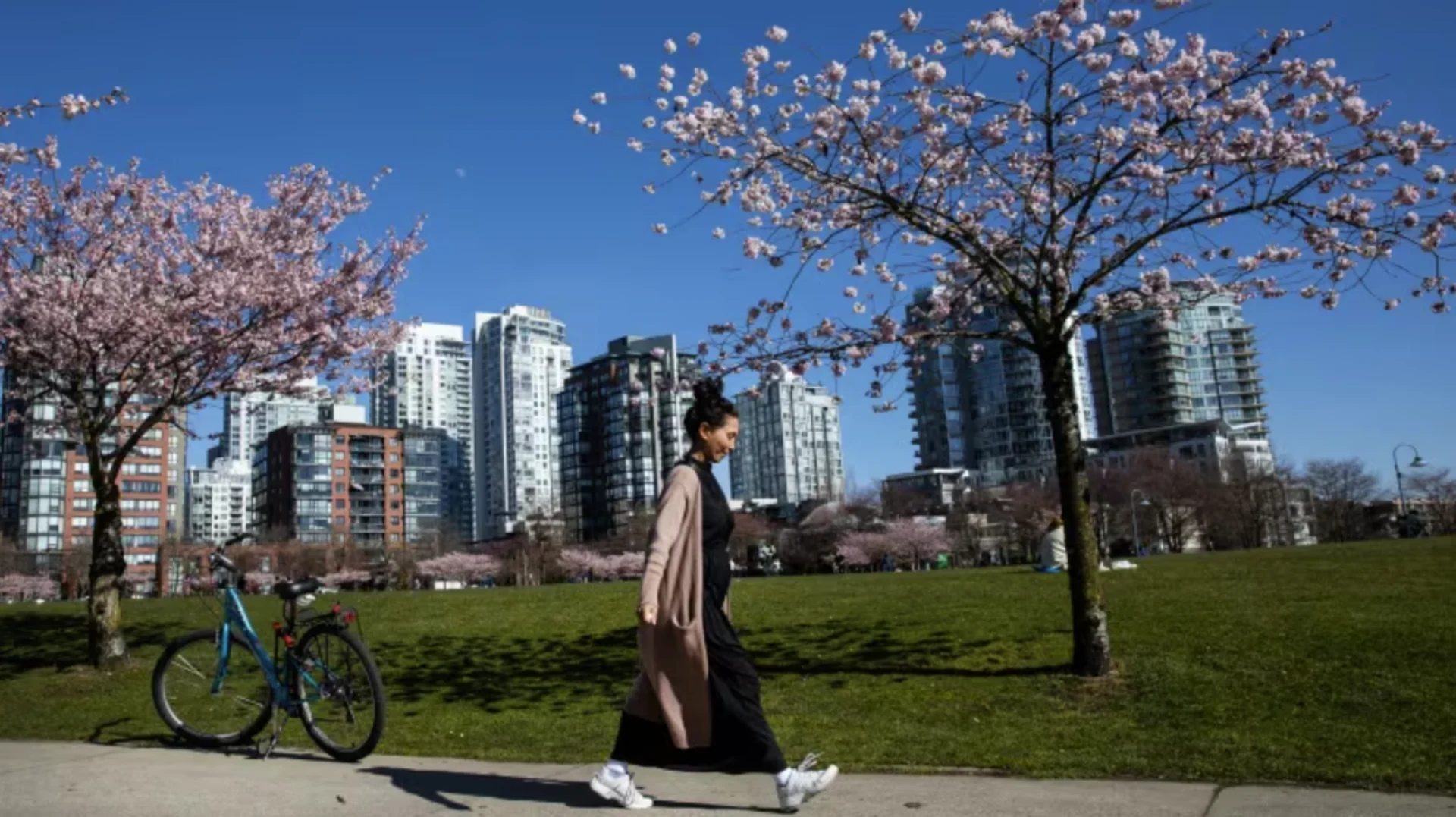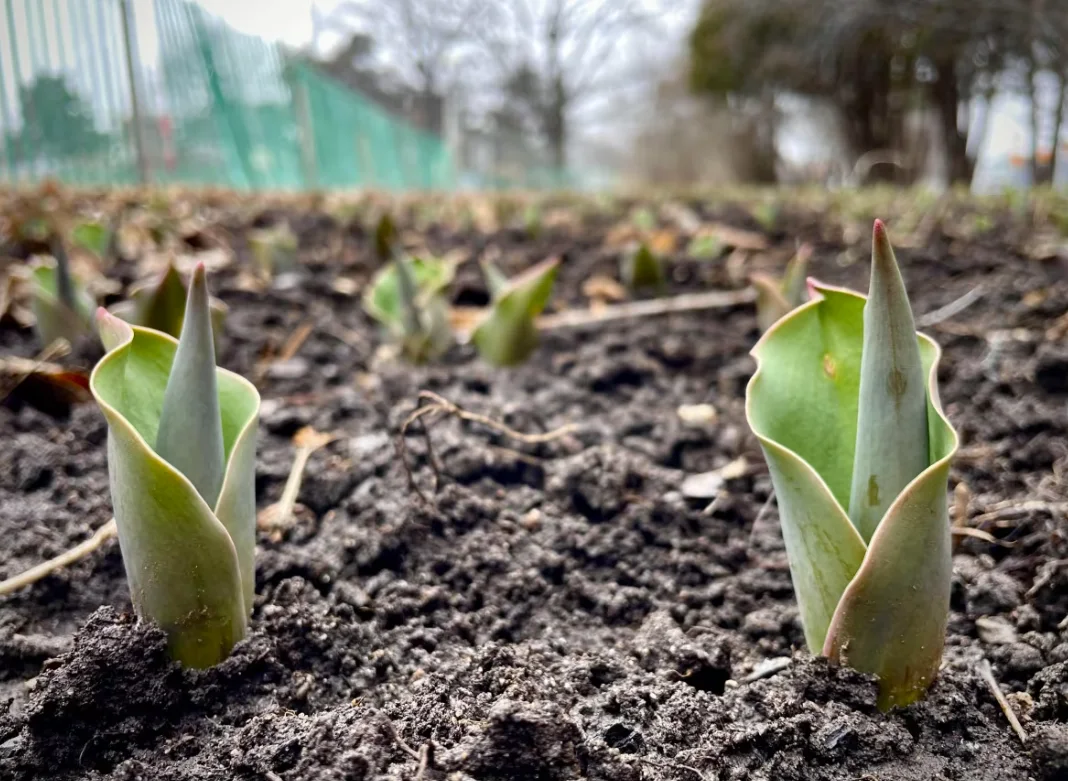
Beware the buds: Why early tulips and cherry blossoms are a growing concern
Senior landscape architect Tina Liu is responsible for up to 700,000 tulip bulbs planted by the National Capital Commission (NCC) each year in Ottawa.
Typically, those tulips would start blooming in April, in staggered cohorts, so the 120 flower beds she oversees at 30 different sites are awash in colour in time for the hundreds of thousands of people who flock to Ottawa for the Canadian Tulip Festival each May.
But this year, in mid-March, some of the tulips are already poking out of the ground by a good two inches, putting them on schedule to bloom one-and-a-half weeks to two weeks early, says Liu, who has overseen the garden beds with the NCC for the past 15 years and says the bloom times have been creeping earlier for the past five years.
"We have seen the effects of climate change," Liu told CBC News. "We have to be really responsive to Mother Nature with these early springs."
RELATED: Plants are flowering earlier than ever – here’s how they sense the seasons
While some may be happy to see tulips already poking up in Ottawa and Calgary and cherry blossoms blooming ahead of schedule in Vancouver as symbols of spring, ecology and horticulture experts say it's a concerning sign of an increasingly warming planet.
Globally, last month was the hottest February on record, averaging 13.54 C and breaking the record set in 2016 by about an eighth of a degree, according to the European Union climate agency Copernicus.
"Early spring feels great when you're walking around on a beautiful spring day, but it does have consequences for the plants and the ecosystems," said Elizabeth Wolkovich, an associate professor of forest and conservation sciences at the University of British Columbia, and a Canada research chair in temporal ecology.
"It, to me, portends to even bigger issues in terms of what's coming this summer for wildfires, and what it means for sea level rises and those really global consequences of climate change."

Tulips that have sprouted at Commissioners Park in Ottawa on Monday are likely to bloom one-to-two weeks early this year, according to the National Capital Commission's senior landscape architect. (Submitted by Tina Liu)
Early spring
Reportable spring events, like when plants start flowering or leafing and when butterflies emerge, have been shifting to earlier in the season for the last 30 years, said Wolkovich, explaining that this is because they're strongly cued to temperature.
And because the North is warming faster than the global average, Canada is experiencing more climate change than many other countries, and spring is arriving sooner, she noted.
According to data from the CBC Climate Dashboard, most major cities in Canada saw higher-than-average minimum temperatures over the last 30 days.
SEE ALSO: You may be seeing some confused early visitors with this early spring warmth
Of the 48 cities CBC analyzed, only 13 had lower-than-average temperatures. The highest temperatures compared to the historical average were found in Thunder Bay, Hamilton and Windsor, Ont.
In southern Ontario, Rodger Tschanz, a horticultural technician at the University of Guelph in the department of plant agriculture, says he's seeing early signs of spring in his gardens. For instance, winter aconite, a yellow flower he normally sees blooming after the snow melts in late March, has been blooming since late February.
"Crocuses are blooming in mid-March when I would normally see them bloom in early April. Primroses are starting to bloom in mid-March — again, I would expect to see these starting three weeks later in the garden," he said.
In Vancouver, Wolkovich says she sees evidence in magnolia trees that are already blooming on her street, and the famed cherry blossom season starting earlier each year.
In the U.S., Washington, D.C., just recorded its second-earliest bloom time for its cherry blossom trees, almost two weeks earlier than the peak bloom a decade ago.
'Big uptick in earlier bloom times'
Elisabeth Beaubien, a plant ecology expert in Edmonton, has been tracking bloom dates in Alberta for decades. In a 2011 article in the journal Bioscience, she noted that over the last 70 years, the bloom dates of two of the earliest-blooming spring plants — the prairie crocus and trembling aspen — had moved forward by two weeks.
In the paper, she explained this was a biological response to climate change. Now, after an exceptionally warm winter, the trend is continuing this year, Beaubien told CBC News.
"I think we're going to see a big uptick in much earlier bloom times," said Beaubien, who has been running a program called Alberta Plant Watch for 37 years.

Bluebells have already coming up in Kirsten Mann's garden in Kemptville, Ont., in this photo taken on March 17, 2024. (Submitted by Kirsten Mann)
The program allows citizens to monitor flowering times for various plants to contribute to annual reports on 26 species. Its website notes a trend toward earlier plant development over the last 100 years in central Alberta.
It's a trend recreational gardeners are noticing, too. Kirsten Mann has been an avid gardener since she was a child, and said she's never once seen her flowers start pushing through the earth before April.
DON'T MISS: Earliest vernal equinox in 128 years kicks off Spring 2024
But this year, by mid-March the 34-year-old from Kemptville, Ont., has already seen tulips, daffodils, crocuses and bluebells sprouting up. And while she says it's nice to see life popping up in the yard, it's also also a little nerve-racking in terms of global warming.
"It makes me think also, 'What can we do to counter that?' " Mann said. "And I think gardening and growing our own vegetables and plants is at least a simple way to contribute."
In Ottawa, Liu has been adjusting her tulip strategies to keep up with temperatures.
When she started with the NCC 15 years ago, about 40 per cent of the bulbs planted each fall were for tulips that would bloom early in the season.
By staggering those with bulbs that would bloom later in spring, the flower beds would stay full all season.
But now, only 15 to 20 per cent of the bulbs they plant are early bloomers, and the rest are late-season bulbs. The goal is to extend the display season as long as possible so people can enjoy the flowers, she said.
"We just deal with nature," Liu said.
Thumbnail image courtesy of Nav Rahi/CBC.
This article, written by Natalie Stechyson, was originally published for CBC News, with files from Graeme Bruce.











